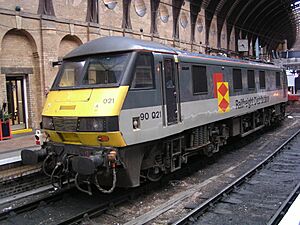Railfreight Distribution facts for kids
 |
|
| State owned | |
| Industry | Rail freight |
| Fate | Split into regional sectors for privatisation |
| Predecessor | Split off from Railfreight in 1988. |
| Successor | 1995: Freightliner (Intermodal) 1996: English Welsh & Scottish (Wagonload) |
| Founded | 1987 |
| Defunct | 1995 |
| Services | Intermodal and Wagonload freight |
| Parent | British Rail |
| Divisions | Speedlink (Wagonload) and Freightliner (Intermodal) |
Railfreight Distribution was a special part of British Rail. It was created in 1987. This company was in charge of moving goods by train that weren't full trainloads. It also handled container services, known as Intermodal. In its early days, it was sometimes called Speedlink Distribution. Later, Railfreight Distribution became responsible for moving freight trains through the Channel Tunnel.
Contents
How Railfreight Distribution Started
In the 1980s, fewer goods were being moved by train. This was because more companies used trucks. Also, the railway network had become smaller. There was less manufacturing in the UK, so fewer raw materials and finished products needed to be moved.
In October 1988, British Rail decided to combine three of its freight services. These were Speedlink (for single wagons), Freightliner (for containers), and Railfreight International (for international goods). They merged them all into one new company: Railfreight Distribution.
Changes and Focus on Long Distances
In 1991, Speedlink, which moved single wagons, was closed down. It had been losing money for many years. Moving single wagons and sorting them in large train yards was very expensive. About 80% of the costs came from these activities. It was found that these services only made money if wagons traveled over 500 miles (800 km). Or, if at least 10 wagons were moved daily.
However, about 70% of the goods that Speedlink used to carry were moved to more efficient train services. These new services used full trains or trains hired by specific companies. After this, Railfreight Distribution focused on the Channel Tunnel. It would be responsible for moving freight trains through the tunnel. This was done with the French train company SNCF.
The company learned that long-distance trips were better. So, they focused on expanding container traffic from ports. These ports included Felixstowe, Southampton, and London Thamesport. This also prepared Railfreight Distribution for more freight traffic from Europe. This increase was expected when the Channel Tunnel opened in the mid-1990s. However, this big increase in traffic did not happen until after the year 2000.
Splitting Up and Selling the Company
When British Rail was privatized, Railfreight Distribution was also split up. In 1995, the part of the business that handled intermodal containers became a separate company. This new company was called Freightliner.
Later, in 1997, the rest of Railfreight Distribution was bought by a company called English Welsh & Scottish.
Locomotives Used
By the time Railfreight Distribution was privatized, its fleet of locomotives included several types. These were:
- Class 47s
- Class 86s
- One Class 87 (number 87101)
- A group of Class 90s
- Class 92s (most of these were stored and waiting to be used)
Some of these trains were owned by other companies like European Passenger Services and SNCF. They were used by all companies as needed. The main bases for these trains were Tinsley and Crewe Electric Depots. However, many other depots were used during Railfreight Distribution's time, especially for smaller shunting locomotives.
Train Paint Schemes (Liveries)
In 1987, Railfreight Distribution introduced a new paint scheme for its trains. It used two shades of grey. This was similar to the designs used by other British Rail freight sectors. The logo had two red diamonds on a yellow background, placed on top of a red square.
In 1992, the paint scheme was updated. This was in preparation for the Channel Tunnel opening. The new 'European' version had dark grey on the upper sides and light grey on the lower sides. The roof was blue. The words 'Railfreight Distribution' were written on the side of the trains.
Also in 1992, three Class 90/1 trains (90128, 90129, and 90130) were painted in "continental" styles. One was blue like trains from Belgium. Another was red like trains from Germany. The third was grey like trains from France. This was to celebrate the Freightconnection Conference. Each of these trains was named "Freightconnection" in the language matching its paint scheme. These three Class 90s were later changed back to their original setup.


